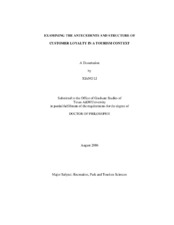| dc.description.abstract | The purpose of this study was to gain an understanding of the structure and
antecedents of cruise passengers' loyalty. Specifically, the study examined the
dimensionality of the loyalty construct. Moreover, the study investigated the utility of
applying the Investment Model (Rusbult 1980, 1983) to reveal the psychological
processes underlying loyalty formation. The study also attempted to, guided by the
Investment Model, integrate the seemingly segregated findings of loyalty antecedents
from marketing and leisure/tourism literature.
Based on the Investment Model and other marketing and leisure/tourism studies
on loyalty, a conceptual framework was established for this study. An online panel
survey was conducted to examine this model. Subjects (N = 554) were online panelists
who were repeat cruisers and who have cruised at least once in the past 12 months.
In this study, loyalty was conceptualized as a four-dimensional construct:
cognitive loyalty, affective loyalty, conative loyalty, and behavioral loyalty. Further, the
first three components were postulated as three subdimensions of a higher order
construct, attitudinal loyalty. However, this conceptualization was not supported by the data. Alternatively, post-hoc analyses revealed that attitudinal loyalty was a first-order
one-dimensional construct, containing cognitve, affective, and conative components.
Moreover, behavioral loyalty was positively and significantly influenced by attitudinal
loyalty. In sum, this study supported the traditional two-dimensional conceptualization
of loyalty, which argues that loyalty has an attitudinal and a behavioral component.
Following the Investment Model, this dissertation suggested that satisfaction,
quality of alternatives, and investment size were three critical antecedents of consumers'
attitudinal loyalty. These theoretical relationships were supported by the present study,
and collectively, the three predictors accounted for over 74 percent of the variance in
attitudinal loyalty. Finally, this dissertation hypothesized that quality and value, two
constructs related to loyalty, served as antecedents of satisfaction, with quality also
leading to value. Results of the study supported all these hypotheses, and satisfaction
was found to partially mediate the quality-attitudinal loyalty, and value-attitudinal
loyalty relationships. Results of the present study provide important direction for the
development of a holistic theoretical framework to explain the formation and structure of
customers' brand loyalty. | en |


